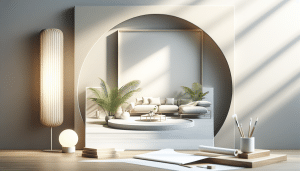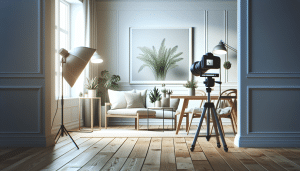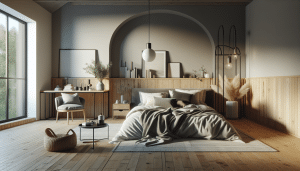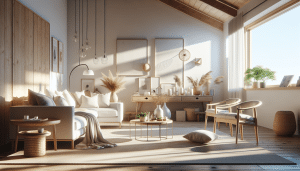Simple Habits That Make Your Home Feel Luxurious
Samantha Lee October 17, 2025
Ever wondered how small lifestyle changes transform a typical space into a retreat you crave? This guide explores how everyday habits, from mindful decluttering to lighting tricks and multi-sensory upgrades, can help you infuse your home with comfort and sophistication.
Create a Welcoming Ambiance With Lighting
Good lighting is often the first thing noticed when entering a home that feels luxurious. It’s not just about brightness; quality light gently draws the eye, shapes mood, and adds dimension to every room. Experimenting with dimmers, warm-tone LEDs, and layered lights—like table lamps or pendant fixtures—can transform plain living areas into inviting spaces. Adequate light also boosts well-being, supports circadian rhythms, and highlights your interior decor, creating that hotel-like ambiance often desired in personal spaces. When chosen thoughtfully, the right lighting can become an affordable upgrade with dramatic impact.
Natural light also plays a big role in a comfortable home atmosphere. Open up curtains during the day and place mirrors strategically to reflect daylight deeper into each room. Even small apartments benefit, as increased daylight visually enlarges spaces and adds energy. Daylight exposure not only reduces the need for harsh artificial bulbs but also enhances mood and productivity. From sheer drapes to reflective surfaces, subtle adjustments can make your home feel more vibrant and expansive while encouraging a sense of tranquility that’s instantly noticeable.
Accent lighting, such as wall sconces or under-cabinet strips, offers another layer of style. These focused lights add drama by highlighting artwork, textured walls, or bookshelves. Smart bulbs, which can change color and intensity, let you personalize the feel for any gathering or quiet night in. Layering ambient, task, and accent lighting will help you fine-tune your home’s mood, ensuring comfort when relaxing or entertaining. Learn more about how lighting choices influence well-being at resources like the U.S. Department of Energy (https://www.energy.gov/energysaver/lighting-choices-save-you-money).
Decluttering for Calm and Spaciousness
Decluttering is a foundational step toward making a home feel elegant and tranquil. The process does not require extreme minimalism, but it does involve intentional editing of what you surround yourself with daily. Start with visible surfaces: clear countertops, coffee tables, and entryways of excess items. Each open area you create visually expands your living space, making it feel inviting and calm. This habit also makes it easier to clean, reduces daily stress, and lets your favorite decor shine without visual noise overwhelming the room.
When decluttering closets and storage areas, use a methodical approach. Sorting items into categories—such as keep, donate, or recycle—helps maintain momentum and ensures that essentials remain accessible. Organizational tools like baskets, labeled bins, and open shelving streamline storage solutions. The result is a home where finding things is easy, and surfaces remain free from constant clutter. These habits foster a sense of mindfulness and order, turning everyday routines into moments of satisfaction rather than frustration. For strategies on effective decluttering, check guides provided by the National Association of Productivity & Organizing Professionals (https://www.napo.net/page/NAPOGOMonth).
Decluttering is not a one-time event but an ongoing habit. Spending just ten minutes daily tidying up maintains open, harmonious spaces long-term. Consider the psychological benefits too: research shows that organized environments lower anxiety and boost creativity. By making organization part of your daily lifestyle, you create lasting calm that influences every aspect of home life. Simple visuals like tidy shelves and clear walkways make rooms feel more expensive and are consistently rated as keys to perceived luxury by home design experts.
Incorporate Touches of Texture and Nature
Luxury at home is often sensed rather than seen. Think about soft throws draped over sofas, plush rugs underfoot, and velvet cushions that invite touch. These textures offer subtle daily comfort and can easily be updated seasonally or by mood. Mixing materials like linen, wool, and wood fosters a layered look—one that’s warm and collected, not cold or impersonal. Such textural variation is a hallmark of sophisticated design seen in boutique hotels and high-end interiors. Even a single faux fur pillow or woven basket can add tactile richness without major renovations.
Bringing elements of nature indoors elevates both decor and well-being. Houseplants purify air, soften lines, and create organic movement. Fresh flowers on a table or a bowl of seasonal fruit infuse color, life, and subtle scent. These simple additions make any setting feel lively and curated. Studies suggest just a few plants per room can help lower stress and elevate mood, providing that restful, spa-like vibe people associate with truly luxurious environments. The presence of nature-connected elements is repeatedly linked to increased happiness and life satisfaction as reported by health organizations like the Environmental Protection Agency (https://www.epa.gov/indoor-air-quality-iaq/indoor-plants-and-air-quality).
Textural accents also enhance visual interest in every room. Arrange collections—ceramics, art books, or travel mementos—on open shelves to mix hard and soft, glossy with matte. These personal displays tell stories, making guests feel connected to the space. Rotating such collections seasonally refreshes interiors with minimal cost or effort, ensuring your home never feels stale.
The Art of Scent and Sound
Scent and sound may be invisible, but their effects on home ambiance are profound. A softly scented room instantly feels more welcoming; it’s subtle cues like these that define high-end hotels and exclusive lounges. Try diffusers with calming essential oils—lavender, eucalyptus, or sandalwood—or natural soy candles to set a gentle fragrance profile. Scented environments create emotional anchors, helping signal relaxation after busy days or energizing mornings. Combining these with other sensory comforts, like soft lighting or gentle fabrics, results in a layered lifestyle experience at home.
Sound design is another secret to enjoying a luxury-feeling space daily. Peaceful playlists, instrumental music, or even the white noise of a desktop fountain drown out distractions and create a cocooning effect. Speaker placement, mindful volume, and curated playlists offer effortless background enhancement for day-to-day living or special occasions. According to research from Harvard University, music and background sound can affect mood, concentration, and overall mental well-being (https://news.harvard.edu/gazette/story/2022/04/why-music-moves-us/).
Combining scent and sound creates environments that are memorable and soothing. The act of lighting a candle after work, starting a peaceful playlist, or brewing coffee while diffusing rosemary oil becomes a comforting ritual. These sensorial routines signal transition from the outside world into a personalized refuge, uplifting both mood and the perceived value of even modest homes. Making scent and sound a part of your daily environment is a simple luxury available to all.
Refresh With Color and Art
Harnessing color is a game-changer in making interiors feel luxurious. Soft neutral walls—creams, taupes, or subtle grays—form a serene foundation, while rich accent colors lend depth. Even small touches, such as deep blue cushions or emerald glassware, catch the eye and elevate ordinary spaces. Paint is an affordable upgrade, and rotating throws or decorative pillows with the seasons keeps the look feeling curated and current. Using colors inspired by nature or resort settings often introduces warmth and comfort that guests and residents alike appreciate.
Art brings identity to any living space. Consider large-scale prints, framed photographs, or thrifted canvases with meaningful themes. Galleries often suggest arranging art in groupings or salon walls—this not only maximizes impact but also creates a bespoke touch seen in high-end homes. Well-chosen art pieces personalize rooms and provide talking points, enhancing hosting experiences. Resources like The Smithsonian Institution’s interior guides suggest that art tailored to personal interests connects people to space, enhances relaxation, and adds meaning to daily living (https://www.si.edu/feature/visit/museumfromhome).
Accessories matter as much as major furnishings. A sculptural vase with fresh greenery or a statement mirror above a console both brighten and visually expand interiors. By mixing color, art, and carefully placed accents, you give even compact homes an exclusive, magazine-worthy appearance without overspending or drastic renovations.
Everyday Rituals That Elevate the Experience
True luxury is rooted in daily routine. Developing small rituals—like brewing loose-leaf tea in a beautiful pot, making your bed each morning, or arranging evening wind-down corners with soft throws and low lights—invites a sense of presence. These mindful acts signal self-care, transforming everyday moments into “personal retreats.” Think of them as the mental equivalent of a five-star experience, encouraging relaxation and gratitude with little effort.
Entertaining with intention shapes a home’s atmosphere too. Serving drinks in glassware, lighting candles for an evening meal, or using cloth napkins elevate shared experiences without formality or expense. These habits make guests (and household members) feel valued. Research from the University of Minnesota highlights that simple rituals—whether shared meals or bedtime routines—enhance happiness and create lasting memories (https://csh.umn.edu/publication/brick-well-paper-meaningful-rituals).
Sustaining beauty and comfort in the home relies on nurturing habits, not just possessions. Investing a few minutes each day in gentle rituals or thoughtful arrangements keeps the sense of luxury fresh. These traditions build emotional attachment, encouraging everyone to participate in caring for the space and genuinely enjoy being at home.
References
1. U.S. Department of Energy. (n.d.). Lighting Choices to Save You Money. Retrieved from https://www.energy.gov/energysaver/lighting-choices-save-you-money
2. National Association of Productivity & Organizing Professionals. (n.d.). Get Organized & Productivity Month. Retrieved from https://www.napo.net/page/NAPOGOMonth
3. U.S. Environmental Protection Agency. (n.d.). Indoor Plants and Air Quality. Retrieved from https://www.epa.gov/indoor-air-quality-iaq/indoor-plants-and-air-quality
4. Harvard Gazette. (2022). Why music moves us. Retrieved from https://news.harvard.edu/gazette/story/2022/04/why-music-moves-us/
5. Smithsonian Institution. (n.d.). Experience the museum from home. Retrieved from https://www.si.edu/feature/visit/museumfromhome
6. University of Minnesota Center for Spirituality & Healing. (n.d.). Brick by Well Paper: The Meaningful Power of Rituals. Retrieved from https://csh.umn.edu/publication/brick-well-paper-meaningful-rituals







